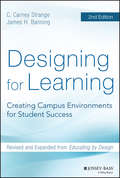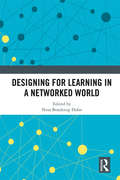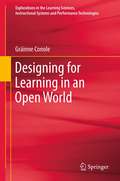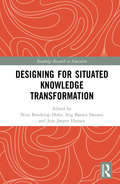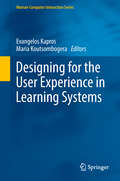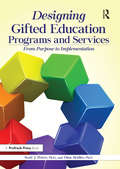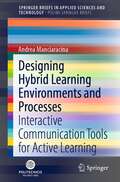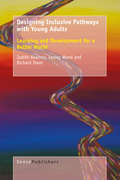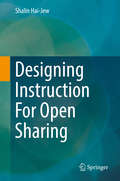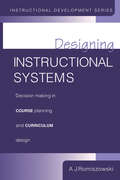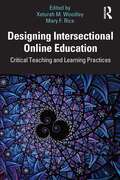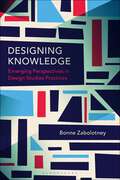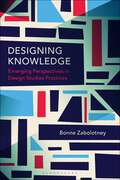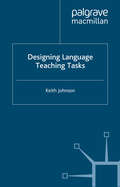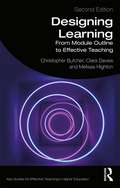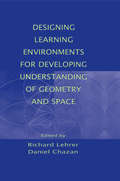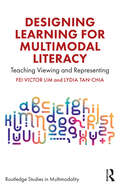- Table View
- List View
Designing for Learning: Creating Campus Environments for Student Success
by C. Carney Strange James H. BanningUnderstand the design factors of campus environmental theory that impact student success and create a campus of consequence Designing for Learning is a comprehensive introduction to campus environmental theory and practice, summarizing the influence of collegiate environments on learning and providing practical strategies for facilitating student success through intentional design. This second edition offers new coverage of universal design, learning communities, multicultural environments, online environments, social networking, and safety, and challenges educators to evaluate the potential for change on their own campuses. You'll learn which factors make a living-learning community effective, and how to implement these factors in the renovation of campus facilities. An updated selection of vignettes, case scenarios, and institutional examples help you apply theory to practice, and end-of-chapter reflection questions allow you to test your understanding and probe deeper into the material and how it applies to your environment. Campus design is no longer just about grassy quads and ivy-covered walls—the past decade has seen a surge in new designs that facilitate learning and nurture student development. This book introduces you to the many design factors that impact student success, and helps you develop a solid strategy for implementing the changes that can make the biggest difference to your campus. Learn how environments shape and influence student behavior Evaluate your campus and consider the potential for change Make your spaces more welcoming, inclusive, and functional Organize the design process from research to policy implementation Colleges and universities are institutions of purpose and place, and the physical design of the facilities must be undertaken with attention to the ways in which the space's dimensions and features impact the behavior and outlook of everyone from students to faculty to staff. Designing for Learning gives you a greater understanding of modern campus design, and the practical application that brings theory to life.
Designing for Learning: Creating Campus Environments for Student Success
by C. Carney Strange James H. BanningUnderstand the design factors of campus environmental theory that impact student success and create a campus of consequence Designing for Learning is a comprehensive introduction to campus environmental theory and practice, summarizing the influence of collegiate environments on learning and providing practical strategies for facilitating student success through intentional design. This second edition offers new coverage of universal design, learning communities, multicultural environments, online environments, social networking, and safety, and challenges educators to evaluate the potential for change on their own campuses. You'll learn which factors make a living-learning community effective, and how to implement these factors in the renovation of campus facilities. An updated selection of vignettes, case scenarios, and institutional examples help you apply theory to practice, and end-of-chapter reflection questions allow you to test your understanding and probe deeper into the material and how it applies to your environment. Campus design is no longer just about grassy quads and ivy-covered walls—the past decade has seen a surge in new designs that facilitate learning and nurture student development. This book introduces you to the many design factors that impact student success, and helps you develop a solid strategy for implementing the changes that can make the biggest difference to your campus. Learn how environments shape and influence student behavior Evaluate your campus and consider the potential for change Make your spaces more welcoming, inclusive, and functional Organize the design process from research to policy implementation Colleges and universities are institutions of purpose and place, and the physical design of the facilities must be undertaken with attention to the ways in which the space's dimensions and features impact the behavior and outlook of everyone from students to faculty to staff. Designing for Learning gives you a greater understanding of modern campus design, and the practical application that brings theory to life.
Designing for Learning in a Networked World (Routledge Research in Education)
by Nina Bonderup DohnDesigning for Learning in a Networked World provides answers to the following questions: what skills are required for living in a networked world; how can educators design for learning these skills and what role can and should networked learning play in a networked world? It discusses central theoretical concepts and draws on current debates about competences necessary to thrive in contemporary society. The book presents detailed analyses of skills needed and investigates the question of how one can design for learning in specific empirical cases, ranging in academic level from preschool to university teaching. The book clarifies the different conceptions of design within the educational field and offers a framework for thinking critically about instances of networked learning. It analyses digital and Computational Literacy and discusses participatory skills for learning in a networked world. Examples of specific empirical cases include teaching programming to students not necessarily intrinsically motivated to learn; facilitation of a participatory public in the library and designs for children’s transition from day-care to primary school, discussed as a matter of networked contexts. Engaging thoughtfully with the question of ‘21st century skills’, this book will be vital reading to scholars, researchers and students within the fields of education, networked learning, learning technology and the learning sciences, digital literacy, design for learning, and library studies.
Designing for Learning in a Networked World (Routledge Research in Education)
by Nina Bonderup DohnDesigning for Learning in a Networked World provides answers to the following questions: what skills are required for living in a networked world; how can educators design for learning these skills and what role can and should networked learning play in a networked world? It discusses central theoretical concepts and draws on current debates about competences necessary to thrive in contemporary society. The book presents detailed analyses of skills needed and investigates the question of how one can design for learning in specific empirical cases, ranging in academic level from preschool to university teaching. The book clarifies the different conceptions of design within the educational field and offers a framework for thinking critically about instances of networked learning. It analyses digital and Computational Literacy and discusses participatory skills for learning in a networked world. Examples of specific empirical cases include teaching programming to students not necessarily intrinsically motivated to learn; facilitation of a participatory public in the library and designs for children’s transition from day-care to primary school, discussed as a matter of networked contexts. Engaging thoughtfully with the question of ‘21st century skills’, this book will be vital reading to scholars, researchers and students within the fields of education, networked learning, learning technology and the learning sciences, digital literacy, design for learning, and library studies.
Designing for Learning in an Open World (Explorations in the Learning Sciences, Instructional Systems and Performance Technologies #4)
by Gráinne ConoleThe Internet and associated technologies have been around for almost twenty years. Networked access and computer ownership are now the norm. There is a plethora of technologies that can be used to support learning, offering different ways in which learners can communicate with each other and their tutors, and providing them with access to interactive, multimedia content. However, these generic skills don’t necessarily translate seamlessly to an academic learning context. Appropriation of these technologies for academic purposes requires specific skills, which means that the way in which we design and support learning opportunities needs to provide appropriate support to harness the potential of technologies. More than ever before learners need supportive ‘learning pathways’ to enable them to blend formal educational offerings, with free resources and services. This requires a rethinking of the design process, to enable teachers to take account of a blended learning context.
Designing for Situated Knowledge Transformation (Routledge Research in Education)
by Nina Bonderup Dohn Stig Børsen Hansen Jens Jørgen HansenHow can knowledge developed in one context be put to use in other contexts? How can students learn to do so? How can educators design for learning this? These are fundamental challenges to many forms of education. The challenges are amplified in contemporary society where people traverse many different contexts and where contexts themselves are continuously changing. Designing for Situated Knowledge Transformation provides a structured answer to these questions, through an investigation of the theoretical, empirical, methodological and pedagogical design aspects which they involve. Raising profound questions about the nature of knowledge, of situativity, and of transfer, transformation and resituation, it calls for and provides extended empirical studies of the forms of transformation that knowledge undergoes when people find themselves in new contexts while relying on existing knowledge. Considering many avenues of practical application and insight, Designing for Situated Knowledge Transformation develops a coherent framework for developing learning designs for knowledge transformation that is crucial in today’s educational settings.
Designing for Situated Knowledge Transformation (Routledge Research in Education)
by Nina Bonderup Dohn Stig Børsen Hansen Jens Jørgen HansenHow can knowledge developed in one context be put to use in other contexts? How can students learn to do so? How can educators design for learning this? These are fundamental challenges to many forms of education. The challenges are amplified in contemporary society where people traverse many different contexts and where contexts themselves are continuously changing. Designing for Situated Knowledge Transformation provides a structured answer to these questions, through an investigation of the theoretical, empirical, methodological and pedagogical design aspects which they involve. Raising profound questions about the nature of knowledge, of situativity, and of transfer, transformation and resituation, it calls for and provides extended empirical studies of the forms of transformation that knowledge undergoes when people find themselves in new contexts while relying on existing knowledge. Considering many avenues of practical application and insight, Designing for Situated Knowledge Transformation develops a coherent framework for developing learning designs for knowledge transformation that is crucial in today’s educational settings.
Designing for the User Experience in Learning Systems (Human–Computer Interaction Series)
by Evangelos Kapros Maria KoutsombogeraWhile the focus of the UX research and design discipline and the Learning Sciences and instructional design disciplines is often similar and almost always tangential, there seems to exist a gap, i.e. a lack of communication between the two fields. Not much has been said about how UX Design can work hand-in-hand with instructional design to advance learning. The goal of this book is to bridge this gap by presenting work that cuts through both fields. To illustrate this gap in more detail, we provide a combined view of UX Research and Design & Educational Technology. While the traditional view has perceived the Learning Experience Design as a field of Instructional Design, we will highlight its connection with UX, an aspect that has become increasingly relevant. Our focus on user experience research and design has a unique emphasis on the human learning experience: we strongly believe that in learning technology the technological part is only mediating the learning experience, and we do not focus on technological advancements per se, as we believe they are not the solution, in themselves, to the problems that education is facing. This book aims to lay out the challenges and opportunities in this field and highlight them through research presented in the various chapters. Thus, it presents a unique opportunity to represent areas of learning technology that go very far beyond the MOOC and the classroom technology. The book provides an outstanding overview and insights in the area and it aims to serve as a significant and valuable source for learning researchers and practitioners. The chapter "User requirements when designing learning e-content: interaction for all" is available open access under a CC BY 4.0 license at link.springer.com
Designing Gifted Education Programs and Services: From Purpose to Implementation
by Scott J. Peters Dina BrullesThis book is intended to support educators in the design and implementation of comprehensive gifted education plans. From planning to actual implementation, this book takes the reader from goals and purpose to assessing student needs and program design. The authors begin with a broad overview of best practices in programming and services, highlighting connections to student needs, programming standards, and state laws. Their recommendations include philosophical, cultural, and practical considerations and data-based decision making. In this book, Peters and Brulles guide the reader through the process of determining the most optimal programming methods for schools to take based on their individual needs and circumstances. With this book, schools will be able to design and develop programs and/or services that lay the foundation necessary to ensure all students are appropriately challenged.
Designing Gifted Education Programs and Services: From Purpose to Implementation
by Scott J. Peters Dina BrullesThis book is intended to support educators in the design and implementation of comprehensive gifted education plans. From planning to actual implementation, this book takes the reader from goals and purpose to assessing student needs and program design. The authors begin with a broad overview of best practices in programming and services, highlighting connections to student needs, programming standards, and state laws. Their recommendations include philosophical, cultural, and practical considerations and data-based decision making. In this book, Peters and Brulles guide the reader through the process of determining the most optimal programming methods for schools to take based on their individual needs and circumstances. With this book, schools will be able to design and develop programs and/or services that lay the foundation necessary to ensure all students are appropriately challenged.
Designing Hybrid Learning Environments and Processes: Interactive Communication Tools for Active Learning (SpringerBriefs in Applied Sciences and Technology)
by Andrea ManciaracinaThis volume explores the relationship between space, pedagogy, and technology, with a particular focus on the latter since it is the connecting element that relates to all analysed contexts. The learning experience is investigated and supported by a review of works by referenced authors, underlining the active learning approach that can create better alliances among users and redefine the role of the teacher as a director and a facilitator. The volume offers a conceptualisation of learning technologies for innovative learning environments by creating a grid of technologies for active approaches. Then, it reflects on the comparison between the on-site and online learning environments, focusing on a stressful context. It offers and discusses an instructional design tool that supports teachers in designing hybrid learning contexts. Practitioners who wish to reframe technology in teaching using both digital and physical resources will find it very inspiring.
Designing Inclusive Pathways with Young Adults: Learning and Development for a Better World
by Judith Kearney Lesley Wood Richard Teare"This book is the second in a series entitled ‘Learning and Development for a Better World’ and it explores the potential for self-directed lifelong action learning (LAL) by focusing on the design of development pathways with and for young adults. The book considers the reasons why LAL pathways are needed and draws on innovative approaches used by the Global University for Lifelong Learning (including micro enterprise, peace-building, music, sport and the creative arts) with examples from nine countries. The aim is to offer a timely response to the pressing global problem of access to learning and development for marginalized young people during the vulnerable period from their mid-teens to mid-twenties.This book is an engaging and compelling text. I enjoyed the flow of ideas and the key messages of need and solution that it provides. The authors are articulate and convincing in their crafted messages – as well as passionate. Reading this book is time well spent and both enjoyable and instructional.Brendan Bartlett, Professor of Education, Institute of Learning Sciences Australia, Australian Catholic UniversityThis book will help both policy makers and those working with young people to change lives. In many areas of the world, young people, particularly women, lead impoverished lives. Developing approaches to lifelong action learning with these young adults will provide hope for the future. Emer Clarke, Formerly Area Director of the UK Learning and Skills CouncilThe plight of millions of young people is clearly worsening as social and economic divisions increase and deepen. This book will serve those well who want to agitate for change and reform based on a belief in social justice and equality of access to learning and economic fairness for all young people.David Davies, Professor Emeritus and Former Executive Dean, University of Derby, UKThis book is a valuable resource, an indispensable text and a must read for all working with young people. What captured my attention most was the way in which it illustrates how access to purposeful learning and development can be provided to marginalized young people. Eldrie Gouws, Professor, Department of Psychology of Education, University of South AfricaThis is a significant and far reaching response to the global problem of young adults’ unemployment and lack of educational opportunities, especially in disadvantaged, remote and poverty-stricken communities in developing as well as developed countries. It is of interest to a wide audience of readers, including youth, parents, educators, non-profit organizations, governments and churches.Ortrun Zuber-Skerritt, Co-author, ‘Lifelong Action Learning for Community Development: Learning and Development for a Better World’, Sense Publishers, 2013"v>
Designing Instruction For Open Sharing
by Shalin Hai-JewThis textbook considers and addresses the design of online learning objects, electronic textbooks, short courses, long courses, MOOC courses, and other types of contents for open sharing. It also considers the design of online mediated communities to enhance such learning. The “openness” may be open-access, and/or it may even be open-source. The learning may range from self-directed and automated to AI robot-led to instructor-led. The main concept of this work is that design learning for open sharing, requires different considerations than when designing for closed and proprietary contexts. Open sharing of learning contents requires a different sense of laws (intellectual property, learner privacy, pedagogical strategies, technologies, media, and others). It requires different considerations of learner diversity and inclusion. It requires geographical, cultural, and linguistic considerations that are not as present in more localized designs. The open sharing aspect also has effects on learner performance tracking (assessments) and learner feedback. This textbook targets students, both undergraduate and graduate in computer science, education and other related fields. Also, professionals in this field managing online systems would find this book helpful.
Designing Instructional Systems: Decision Making in Course Planning and Curriculum Design
by Romiszowski, A. J.First Published in 1984. Routledge is an imprint of Taylor & Francis, an informa company.
Designing Instructional Systems: Decision Making in Course Planning and Curriculum Design
by Romiszowski, A. J.First Published in 1984. Routledge is an imprint of Taylor & Francis, an informa company.
Designing Intersectional Online Education: Critical Teaching and Learning Practices
by Xeturah M. WoodleyDesigning Intersectional Online Education provides expansive yet accessible examples and discussion about the intentional creation of online teaching and learning experiences that critically center identity, social systems, and other important ideas in design and pedagogy. Instructors are increasingly tasked with designing their own online courses, curricula, and activities but lack information to support their attention to the ever-shifting, overlapping contexts and constructs that inform students’ positions within knowledge and schooling. This book infuses today’s technology-enhanced education environments with practices derived from critical race theory, culturally responsive pedagogy, disability studies, feminist/womanist studies, queer theory, and other essential foundations for humanized and socially just education. Faculty, scholars, technologists, and other experts across higher education, K-12, and teacher training offer fresh, robust insights into how actively engaging with intersectionality can inspire designs for online teaching and learning that are inclusive, intergenerational, anti-oppressive, and emancipatory.
Designing Intersectional Online Education: Critical Teaching and Learning Practices
by Xeturah M. Woodley Mary F. RiceDesigning Intersectional Online Education provides expansive yet accessible examples and discussion about the intentional creation of online teaching and learning experiences that critically center identity, social systems, and other important ideas in design and pedagogy. Instructors are increasingly tasked with designing their own online courses, curricula, and activities but lack information to support their attention to the ever-shifting, overlapping contexts and constructs that inform students’ positions within knowledge and schooling. This book infuses today’s technology-enhanced education environments with practices derived from critical race theory, culturally responsive pedagogy, disability studies, feminist/womanist studies, queer theory, and other essential foundations for humanized and socially just education. Faculty, scholars, technologists, and other experts across higher education, K-12, and teacher training offer fresh, robust insights into how actively engaging with intersectionality can inspire designs for online teaching and learning that are inclusive, intergenerational, anti-oppressive, and emancipatory.
Designing Knowledge: Emerging Perspectives in Design Studies Practices
by Ian WardBy positioning designers and their practices at the center of design studies, Designing Knowledge merges theory and practice to highlight how knowledge creation can contribute to an expanded and more inclusive design practice. Bringing together a rich variety of perspectives, methods and approaches, and by exploring and critiquing current issues in design studies, this book encourages designers to reflect on their work in a new light. Design studies practice is a material and tangible focus on knowledge production and mobilization in the field of design. Throughout 15 chapters featuring a wide range of case studies, design practitioners and theorists address how they produce and mobilize knowledge about design through their practice. Chapters explore how to dismantle the colonial structures of modernist design and depart from the privileged spaces of art historical concepts in design history. They address tensions between traditional Indigenous design and contemporary design practice, discuss how to authentically integrate personhood into practice and explore topics such as designing wellbeing, developing communities of care, informed accountability and principles of the ecocene. They also analyse languages and typographic representations and investigate the nature of the graphic and typographic translation of literary texts, focusing on the writing of Argentinian writer Jorge Luis Borges as a case study.This book elevates the voices of designers and their work and offers insights to professional designers as well as students on how to use these contributions when working on future projects. By highlighting the awareness of designers throughout their practice, this book will inspire others to reflect on their work and share their own knowledge for the benefit of the field of design.
Designing Knowledge: Emerging Perspectives in Design Studies Practices
By positioning designers and their practices at the center of design studies, Designing Knowledge merges theory and practice to highlight how knowledge creation can contribute to an expanded and more inclusive design practice. Bringing together a rich variety of perspectives, methods and approaches, and by exploring and critiquing current issues in design studies, this book encourages designers to reflect on their work in a new light. Design studies practice is a material and tangible focus on knowledge production and mobilization in the field of design. Throughout 15 chapters featuring a wide range of case studies, design practitioners and theorists address how they produce and mobilize knowledge about design through their practice. Chapters explore how to dismantle the colonial structures of modernist design and depart from the privileged spaces of art historical concepts in design history. They address tensions between traditional Indigenous design and contemporary design practice, discuss how to authentically integrate personhood into practice and explore topics such as designing wellbeing, developing communities of care, informed accountability and principles of the ecocene. They also analyse languages and typographic representations and investigate the nature of the graphic and typographic translation of literary texts, focusing on the writing of Argentinian writer Jorge Luis Borges as a case study.This book elevates the voices of designers and their work and offers insights to professional designers as well as students on how to use these contributions when working on future projects. By highlighting the awareness of designers throughout their practice, this book will inspire others to reflect on their work and share their own knowledge for the benefit of the field of design.
Designing Language Teaching Tasks
by K. JohnsonShort-listed for the British Council Innovation Awards 2004 that promote and reward excellence in English Language Teaching Designing Language Teaching Tasks provides a research-based account of how experienced teachers and task designers prepare activities for use in the language classroom. It gives detailed information on the procedures which designers follow. The book is a description of research and will therefore interest applied linguists and students in the field. It is written in a clear and comprehensible way, and should appeal to all those who want to learn to write good language teaching materials.
Designing Learning: From Module Outline to Effective Teaching (Key Guides for Effective Teaching in Higher Education)
by Christopher Butcher Clara Davies Melissa HightonBridging the gap between theory and practice, this fully updated new edition of Designing Learning offers accessible guidance to help those new to teaching in higher education to design and develop a course. With new considerations to the higher education context, this book uses current educational research to support staff in their endeavour to design and develop modules and degree courses of the highest quality. Offering guidance on every stage, from planning to preparing materials and resources, with a focus on the promotion of learning, this book considers: Course design models and shapes and their impact on learning How the external influences of learning and teaching are translated by different institutions How to match the content of a course to its outcomes Frameworks to enable communication between staff and students about expectations and standards Taking into account the diverse student population when designing a course The place of VLE, communication tools and systems for monitoring students‘ engagement The importance of linking all aspects of the taught curriculum and wider co-/extra-curricular activities to support learning Ways to evaluate and enhance a course and to develop oneself as a teaching professional in HE. Providing advice, illustrative examples and case studies, Designing Learning is a comprehensive guide to designing a high quality course. This book is a must-read for any academic looking to create or update their course or module.
Designing Learning: From Module Outline to Effective Teaching (Key Guides for Effective Teaching in Higher Education)
by Christopher Butcher Clara Davies Melissa HightonBridging the gap between theory and practice, this fully updated new edition of Designing Learning offers accessible guidance to help those new to teaching in higher education to design and develop a course. With new considerations to the higher education context, this book uses current educational research to support staff in their endeavour to design and develop modules and degree courses of the highest quality. Offering guidance on every stage, from planning to preparing materials and resources, with a focus on the promotion of learning, this book considers: Course design models and shapes and their impact on learning How the external influences of learning and teaching are translated by different institutions How to match the content of a course to its outcomes Frameworks to enable communication between staff and students about expectations and standards Taking into account the diverse student population when designing a course The place of VLE, communication tools and systems for monitoring students‘ engagement The importance of linking all aspects of the taught curriculum and wider co-/extra-curricular activities to support learning Ways to evaluate and enhance a course and to develop oneself as a teaching professional in HE. Providing advice, illustrative examples and case studies, Designing Learning is a comprehensive guide to designing a high quality course. This book is a must-read for any academic looking to create or update their course or module.
Designing Learning Environments for Developing Understanding of Geometry and Space (Studies in Mathematical Thinking and Learning Series)
by Richard Lehrer Daniel ChazanThis volume reflects an appreciation of the interactive roles of subject matter, teacher, student, and technologies in designing classrooms that promote understanding of geometry and space. Although these elements of geometry education are mutually constituted, the book is organized to highlight, first, the editors' vision of a general geometry education; second, the development of student thinking in everyday and classroom contexts; and third, the role of technologies.Rather than looking to high school geometry as the locus--and all too often, the apex--of geometric reasoning, the contributors to this volume suggest that reasoning about space can and should be successfully integrated with other forms of mathematics, starting at the elementary level and continuing through high school. Reintegrating spatial reasoning into the mathematical mainstream--indeed, placing it at the core of K-12 mathematics environments that promote learning with understanding--will mean increased attention to problems in modeling, structure, and design and reinvigoration of traditional topics such as measure, dimension, and form. Further, the editors' position is that the teaching of geometry and spatial visualization in school should not be compressed into a characterization of Greek geometry, but should include attention to contributions to the mathematics of space that developed subsequent to those of the Greeks.This volume is essential reading for those involved in mathematics education at all levels, including university faculty, researchers, and graduate students.
Designing Learning Environments for Developing Understanding of Geometry and Space (Studies in Mathematical Thinking and Learning Series)
by Richard Lehrer Daniel ChazanThis volume reflects an appreciation of the interactive roles of subject matter, teacher, student, and technologies in designing classrooms that promote understanding of geometry and space. Although these elements of geometry education are mutually constituted, the book is organized to highlight, first, the editors' vision of a general geometry education; second, the development of student thinking in everyday and classroom contexts; and third, the role of technologies.Rather than looking to high school geometry as the locus--and all too often, the apex--of geometric reasoning, the contributors to this volume suggest that reasoning about space can and should be successfully integrated with other forms of mathematics, starting at the elementary level and continuing through high school. Reintegrating spatial reasoning into the mathematical mainstream--indeed, placing it at the core of K-12 mathematics environments that promote learning with understanding--will mean increased attention to problems in modeling, structure, and design and reinvigoration of traditional topics such as measure, dimension, and form. Further, the editors' position is that the teaching of geometry and spatial visualization in school should not be compressed into a characterization of Greek geometry, but should include attention to contributions to the mathematics of space that developed subsequent to those of the Greeks.This volume is essential reading for those involved in mathematics education at all levels, including university faculty, researchers, and graduate students.
Designing Learning for Multimodal Literacy: Teaching Viewing and Representing (Routledge Studies in Multimodality)
by Fei Victor Lim Lydia Tan-ChiaDesigning Learning for Multimodal Literacy addresses the need to design learning for multimodal literacy in a world that is increasingly saturated with print and digital media. In the current age, communication and interactions on social media are seldom made with language alone but are often accompanied with emojis, images, and videos, making meanings multimodally. Young people, including children, are also increasingly active in making videos of themselves, their ideas, and their experiences as part of their out-of-school literacy activities. In particular, for language teachers, the present shifts in our world require that teachers re-examine what they teach and how they can meaningfully and effectively teach the students in their classes today. At 8 years old, Alden created his own rap music video and shared it with the world. He wrote his own lyrics and set it against the music he remixed and meshed from a music download site. Alden is in your classroom today. As his teacher, what would you teach him? How would you engage him? Alden, and children like him, is the inspiration for why the authors have written this book. The changing times and changing learners place a demand on educators to continually reflect on what and how teachers are teaching their students – to ensure that learning in school remains relevant, relatable, and prepares them for the world of the future. Lim’s book outlines how teachers can design learning for multimodal literacy. It is a result of a collaboration between an educational researcher and a curriculum developer, and offers practical resources for practitioners but also design principles and considerations based on practice with a range of students to inform and inspire academics and postgraduate students. It is poised to contribute to the global conversation and interest on how educators can reflect on the zeitgeist of the digital age and design learning for multimodal literacy.
